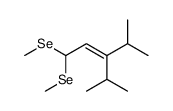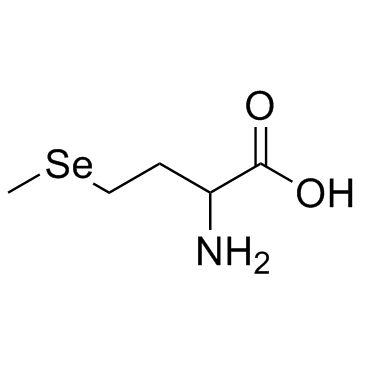6486-05-1
| Name | methylselenol |
|---|---|
| Synonyms | methyl selenol |
| Molecular Formula | CH4Se |
|---|---|
| Molecular Weight | 95.00250 |
| Exact Mass | 95.94780 |
| LogP | 0.31550 |
Synonym:None Section 2 - COMPOSITION, INFORMATION ON INGREDIENTS
Risk Phrases: 23/25 33 Section 3 - HAZARDS IDENTIFICATION EMERGENCY OVERVIEW
Toxic by inhalation and if swallowed. Danger of cumulative effects.The toxicological properties of this material have not been fully investigated. Potential Health Effects Eye: Causes eye irritation. May result in corneal injury. Skin: Causes skin irritation and possible burns. Contact with the skin may cause the skin to appear to be blue and the nails brittle and yellow. Ingestion: May cause irritation of the digestive tract. The toxicological properties of this substance have not been fully investigated. May cause alopecia (loss of hair). Effects may be delayed. May cause garlic smell on the breath and body. Inhalation: Effects may be delayed. May cause respiratory tract irritation. The toxicological properties of this substance have not been fully investigated. Vapor harmful. Vapors may cause dizziness or suffocation. May produce anemia, leucocytosis (increase in the white blood cell count) , cloudy swelling and fatty degeneration of the viscera. Chronic: Chronic exposure to selenium may cause central nervous system effects, digestive tract disturbances, pallor, garlic breath, Chronic exposure to selenium may cause pallor, garlic breath, metallic taste, anemia, liver and spleen damage. Chronic selenium poisoning is characterized by loss of hair and nails, skin lesions, and abnormalities of the nervous system. Section 4 - FIRST AID MEASURES Eyes: Immediately flush eyes with plenty of water for at least 15 minutes, occasionally lifting the upper and lower eyelids. Get medical aid. Skin: Get medical aid. Immediately flush skin with plenty of water for at least 15 minutes while removing contaminated clothing and shoes. Wash clothing before reuse. Ingestion: Never give anything by mouth to an unconscious person. Get medical aid. Do NOT induce vomiting. If conscious and alert, rinse mouth and drink 2-4 cupfuls of milk or water. Wash mouth out with water. Inhalation: Remove from exposure and move to fresh air immediately. If breathing is difficult, give oxygen. Get medical aid. Do NOT use mouth-to-mouth resuscitation. If breathing has ceased apply artificial respiration using oxygen and a suitable mechanical device such as a bag and a mask. Notes to Physician: Treat symptomatically and supportively. Section 5 - FIRE FIGHTING MEASURES General Information: As in any fire, wear a self-contained breathing apparatus in pressure-demand, MSHA/NIOSH (approved or equivalent), and full protective gear. During a fire, irritating and highly toxic gases may be generated by thermal decomposition or combustion. Use water spray to keep fire-exposed containers cool. Vapors may be heavier than air. They can spread along the ground and collect in low or confined areas. Containers may explode when heated. Extinguishing Media: Use agent most appropriate to extinguish fire. Cool containers with flooding quantities of water until well after fire is out. Use water spray, dry chemical, carbon dioxide, or appropriate foam. Section 6 - ACCIDENTAL RELEASE MEASURES General Information: Use proper personal protective equipment as indicated in Section 8. Spills/Leaks: Absorb spill with inert material (e.g. vermiculite, sand or earth), then place in suitable container. Avoid runoff into storm sewers and ditches which lead to waterways. Clean up spills immediately, observing precautions in the Protective Equipment section. Provide ventilation. Section 7 - HANDLING and STORAGE Handling: Wash thoroughly after handling. Wash hands before eating. Use with adequate ventilation. Avoid contact with eyes, skin, and clothing. Keep container tightly closed. Avoid ingestion and inhalation. Use and store under argon. Use only in a chemical fume hood. Wash clothing before reuse. Storage: Store in a tightly closed container. Keep under an argon blanket. Store in a cool, dry, well-ventilated area away from incompatible substances. Section 8 - EXPOSURE CONTROLS, PERSONAL PROTECTION Engineering Controls: Facilities storing or utilizing this material should be equipped with an eyewash facility and a safety shower. Use adequate ventilation to keep airborne concentrations low. Exposure Limits CAS# 6486-05-1: United Kingdom, WEL - TWA: (listed as selenium compounds): 0.1 mg TWA (except hydrogen selenide, as Se) United Kingdom, WEL - STEL: (listed as selenium compounds): 0.3 m STEL (except hydrogen selenide, as Se) United States OSHA: 0.2 mg/m3 TWA (as Se) (listed under Selenium compounds). Belgium - TWA: (listed as selenium compounds): 0.2 mg/m3 VLE (as Japan: (listed as selenium compounds): 0.1 mg/m3 OEL (except SeH2 SeF6, as Se) Malaysia: (listed as selenium compounds): 0.2 mg/m3 TWA (as Se) Netherlands: (listed as selenium compounds): 0.1 mg/m3 MAC (as Se Spain: (listed as selenium compounds): 0.1 mg/m3 VLA-ED (except hydrogen selenide, as Se) Personal Protective Equipment Eyes: Wear appropriate protective eyeglasses or chemical safety goggles as described by OSHA's eye and face protection regulations in 29 CFR 1910.133 or European Standard EN166. Skin: Wear appropriate protective gloves to prevent skin exposure. Clothing: Wear appropriate protective clothing to prevent skin exposure. Respirators: A respiratory protection program that meets OSHA's 29 CFR 1910.134 and ANSI Z88.2 requirements or European Standard EN 149 must be followed whenever workplace conditions warrant respirator use. Section 9 - PHYSICAL AND CHEMICAL PROPERTIES Physical State: Liquid Color: colorless Odor: Stench pH: Not available. Vapor Pressure: Not available. Viscosity: Not available. Boiling Point: Not available. Freezing/Melting Point: Not available. Autoignition Temperature: Not available. Flash Point: Not available. Explosion Limits, lower: Not available. Explosion Limits, upper: Not available. Decomposition Temperature: Solubility in water: Specific Gravity/Density: Molecular Formula: CH4Se Molecular Weight: 95.00 Section 10 - STABILITY AND REACTIVITY Chemical Stability: Stable at room temperature in closed containers under normal storage and handling conditions. Conditions to Avoid: Incompatible materials, excess heat. Incompatibilities with Other Materials: Oxidizing agents. Hazardous Decomposition Products: Carbon monoxide, irritating and toxic fumes and gases, carbon dioxide, selenium/selenium oxides. Hazardous Polymerization: Has not been reported. Section 11 - TOXICOLOGICAL INFORMATION RTECS#: CAS# 6486-05-1 unlisted. LD50/LC50: Not available. Carcinogenicity: METHYLSELENOL - Not listed by ACGIH, IARC, or NTP. Section 12 - ECOLOGICAL INFORMATION Section 13 - DISPOSAL CONSIDERATIONS Dispose of in a manner consistent with federal, state, and local regulations. Section 14 - TRANSPORT INFORMATION IATA Shipping Name: TOXIC LIQUID, ORGANIC, N.O.S.* Hazard Class: 6.1 UN Number: 2810 Packing Group: I IMO Shipping Name: TOXIC LIQUID, ORGANIC, N.O.S. Hazard Class: 6.1 UN Number: 2810 Packing Group: I RID/ADR Shipping Name: TOXIC LIQUID, ORGANIC, N.O.S. Hazard Class: 6.1 UN Number: 2810 Packing group: I Section 15 - REGULATORY INFORMATION European/International Regulations European Labeling in Accordance with EC Directives Hazard Symbols: T Risk Phrases: R 23/25 Toxic by inhalation and if swallowed. R 33 Danger of cumulative effects. Safety Phrases: S 20/21 When using do not eat, drink or smoke. S 28A After contact with skin, wash immediately with plenty of water. S 37 Wear suitable gloves. S 45 In case of accident or if you feel unwell, seek medical advice immediately (show the label where possible). WGK (Water Danger/Protection) CAS# 6486-05-1: No information available. Canada None of the chemicals in this product are listed on the DSL/NDSL list. CAS# 6486-05-1 is not listed on Canada's Ingredient Disclosure List. US FEDERAL TSCA CAS# 6486-05-1 is not listed on the TSCA inventory. It is for research and development use only. SECTION 16 - ADDITIONAL INFORMATION N/A |
| HS Code | 2905199090 |
|---|
| Precursor 0 | |
|---|---|
| DownStream 10 | |
| HS Code | 2905199090 |
|---|---|
| Summary | 2905199090. saturated monohydric alcohols. VAT:17.0%. Tax rebate rate:13.0%. . MFN tariff:5.5%. General tariff:30.0% |




![1-[1,1-bis(methylselanyl)ethyl]-4-methylbenzene structure](https://image.chemsrc.com/caspic/344/103971-57-9.png)





![1-[1,1-bis(methylselanyl)ethyl]-4-methoxybenzene structure](https://image.chemsrc.com/caspic/376/75155-23-6.png)